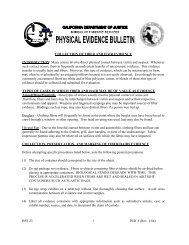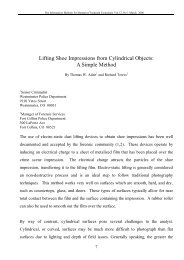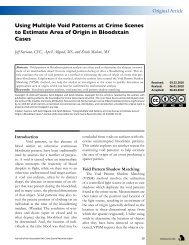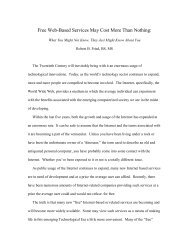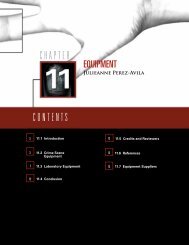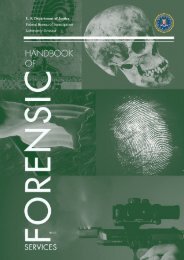PHYSICAL EVIDENCE MANUAL - Crime Scene Investigator Network
PHYSICAL EVIDENCE MANUAL - Crime Scene Investigator Network
PHYSICAL EVIDENCE MANUAL - Crime Scene Investigator Network
Create successful ePaper yourself
Turn your PDF publications into a flip-book with our unique Google optimized e-Paper software.
Physical Evidence Manual<br />
Collection and Packaging<br />
Items removed from a body orifice as well as syringe contents should be labeled<br />
with a “BIOHAZARD” label.<br />
Live plant material and other damp/wet evidence should be dried prior to<br />
submission. This includes marijuana, mushrooms, peyote, or opium poppies.<br />
Fresh plant material, when packaged in airtight containers such as plastic bags,<br />
decays rapidly and can inhibit or possibly eliminate the chance for detecting a<br />
controlled substance. Suspected fresh khat should be frozen and submitted as<br />
soon as possible.<br />
Suspected LSD should be kept away from direct light. Potentially spiked liquids<br />
should be submitted in a timely manner.<br />
Drug packaging that needs processing for latent fingerprints should be separated<br />
from the drugs when possible. The evidence for latent fingerprint processing is<br />
then submitted separately from the drugs.<br />
Care should be exercised when packaging more than one exhibit in the same<br />
package. Cross contamination of evidence can occur, especially with bags that<br />
are open, leaking, or have cut corners. All submitted items must be written on<br />
the Form 49.<br />
Adopted: May 2002<br />
Revisions: 6<br />
Last Revision: January 31, 2008<br />
Figure 2: Marijuana leaves on a growing plant. If<br />
you encounter such evidence, uproot the plant<br />
and shake the soil from the roots, allow it to airdry,<br />
and package.<br />
7-2



